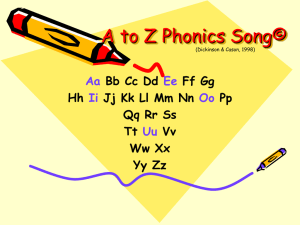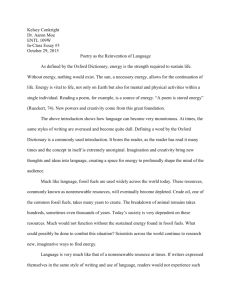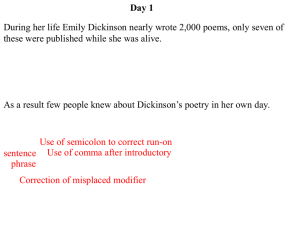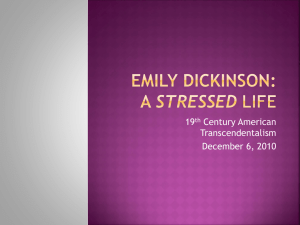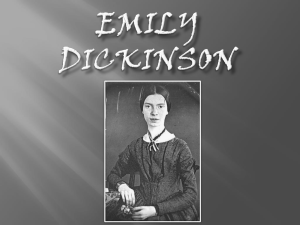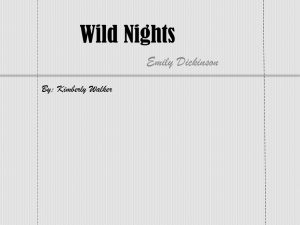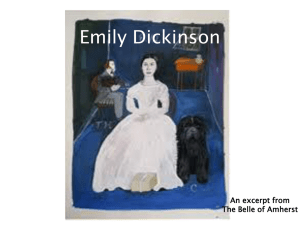Dickinson devoted a great amount of her work to exploring the
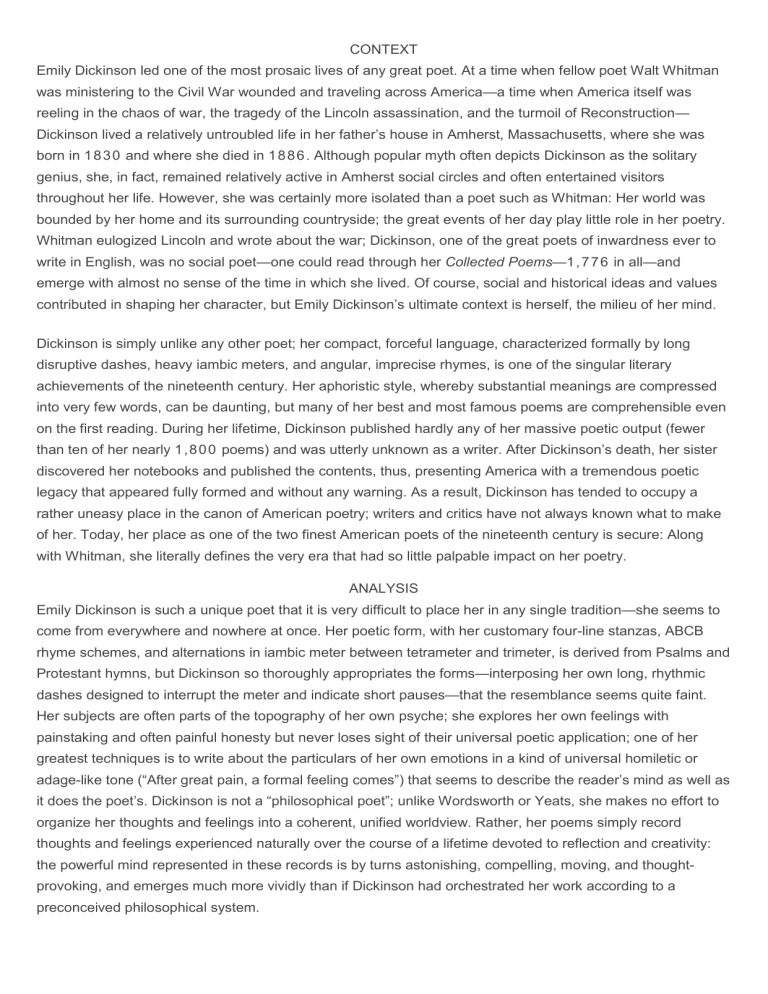
CONTEXT
Emily Dickinson led one of the most prosaic lives of any great poet. At a time when fellow poet Walt Whitman was ministering to the Civil War wounded and traveling across America —a time when America itself was reeling in the chaos of war, the tragedy of the Lincoln assassination, and the turmoil of Reconstruction —
Dickinson lived a relatively untroubled life in her father’s house in Amherst, Massachusetts, where she was born in 1 8 3 0 and where she died in 1 8 8 6 . Although popular myth often depicts Dickinson as the solitary genius, she, in fact, remained relatively active in Amherst social circles and often entertained visitors throughout her life. However, she was certainly more isolated than a poet such as Whitman: Her world was bounded by her home and its surrounding countryside; the great events of her day play little role in her poetry.
Whitman eulogized Lincoln and wrote about the war; Dickinson, one of the great poets of inwardness ever to write in English, was no social poet —one could read through her Collected Poems —1, 776 in all—and emerge with almost no sense of the time in which she lived. Of course, social and historical ideas and values contributed in shaping her character, but Emily Dickinson’s ultimate context is herself, the milieu of her mind.
Dickinson is simply unlike any other poet; her compact, forceful language, characterized formally by long disruptive dashes, heavy iambic meters, and angular, imprecise rhymes, is one of the singular literary achievements of the nineteenth century. Her aphoristic style, whereby substantial meanings are compressed into very few words, can be daunting, but many of her best and most famous poems are comprehensible even on the first reading. During her lifetime, Dickinson published hardly any of her massive poetic output (fewer than ten of her nearly 1 , 8 0 0 poems) and was utterly unknown as a writer. After Dickinson’s death, her sister discovered her notebooks and published the contents, thus, presenting America with a tremendous poetic legacy that appeared fully formed and without any warning. As a result, Dickinson has tended to occupy a rather uneasy place in the canon of American poetry; writers and critics have not always known what to make of her. Today, her place as one of the two finest American poets of the nineteenth century is secure: Along with Whitman, she literally defines the very era that had so little palpable impact on her poetry.
ANALYSIS
Emily Dickinson is such a unique poet that it is very difficult to place her in any single tradition —she seems to come from everywhere and nowhere at once. Her poetic form, with her customary four-line stanzas, ABCB rhyme schemes, and alternations in iambic meter between tetrameter and trimeter, is derived from Psalms and
Protestant hymns, but Dickinson so thoroughly appropriates the forms —interposing her own long, rhythmic dashes designed to interrupt the meter and indicate short pauses —that the resemblance seems quite faint.
Her subjects are often parts of the topography of her own psyche; she explores her own feelings with painstaking and often painful honesty but never loses sight of their universal poetic application; one of her greatest techniques is to write about the particulars of her own emotions in a kind of universal homiletic or adage-like to ne (“After great pain, a formal feeling comes”) that seems to describe the reader’s mind as well as it does the poet’s. Dickinson is not a “philosophical poet”; unlike Wordsworth or Yeats, she makes no effort to organize her thoughts and feelings into a coherent, unified worldview. Rather, her poems simply record thoughts and feelings experienced naturally over the course of a lifetime devoted to reflection and creativity: the powerful mind represented in these records is by turns astonishing, compelling, moving, and thoughtprovoking, and emerges much more vividly than if Dickinson had orchestrated her work according to a preconceived philosophical system.
Of course, Dickinson’s greatest achievement as a poet of inwardness is her brilliant, diamond-hard language.
Dickinson often writes aphoristically, meaning that she compresses a great deal of meaning into a very small number of words. This can make her poems hard to understand on a first reading, but when their meaning does unveil itself, it often explodes in the mind all at once, and lines that seemed baffling can become intensely and unforgettably clear. Other poems —many of her most famous, in fact—are much less difficult to understand, and they exhibit her extraordinary powers of observation and descript ion. Dickinson’s imagination can lead her into very peculiar territory —some of her most famous poems are bizarre death-fantasies and astonishing metaphorical conceits —but she is equally deft in her navigation of the domestic, writing beautiful nature-lyrics alongside her wild flights of imagination and often combining the two with great facility.
Themes
The Individual’s Struggle with God
THEMES, MOTIFS & SYMBOLS
Dickinson devoted a great amount of her work to exploring the relationship between an individual and a Judeo-
Christian God. Many poems describe a protracted rebellion against the God whom she deemed scornful and indifferent to human suffering, a divine being perpetually committed to subjugating human identity. In a sense, she was a religious poet. Unlike other religious poets, who inevitably saw themselves as subordinate to God,
Dickinson rejected this premise in her poetry. She was dissatisfied with the notion that the poet can engage with God only insofar as God ordains the poet as his instrument, and she challenged God’s dominion throughout her life, refusing to submit to his divine will at the cost of her self. Perhaps her most fiery challenge comes in “Mine by the Right of the White Election!” (528), in which the speaker roars in revolt against God, claiming the earth and heavens for herself or himself.
Elsewhere, Dickinson’s poetry criticizes God not by speaking out directly against him, but by detailing the suffering he causes and his various affronts to an individual’s sense of self. Though the speaker of “Tell all the
Truth but tell it slant” (1129) never mentions God, the poem refers obliquely to his suppression of the apostle
Paul in the last two lines. Here, the speaker describes how unmitigated truth (in the form of light) causes blindness. In the Bible (Acts 9 :4 ), God decides to enlighten Paul by making him blind and then healing him on the condition that thenceforth Paul becomes “a chosen vessel” of God, performing his will. The speaker recoils from this instance of God’s juggernaut-like domination of Paul in this poem but follows the poem’s advice and tells the truth “slant,” or indirectly, rather than censuring God directly. In another instance of implicit criticism,
Dickinson portrays God as a murderous hunter of man in “My Life had stood—a Loaded Gun” (754), in which
Death goes about gleefully executing people for his divine master. These poems are among the hundreds of verses in which Dickinson portrays God as aloof, cruel, invasive, insensitive, or vindictive.
The Assertion of the Self
In her work, Dickinson asserts the importance of the self, a theme closely related to Dickinson’s censure of
God. As Dickinson understood it, the mere act of speaking or writing is an affirmation of the will, and the call of the poet, in particular, is the call to explore and express the self to others. For Dickinson, the “self” entails an understanding of identity according to the way it systematizes its perceptions of the world, forms its goals and values, and comes to judgments regarding what it perceives.
Nearly all Dickinson’s speakers behave according to the primacy of the self, despite the efforts of others to intrude on them. Indeed, the self is never more apparent in Dickinson’s poetry than when the speaker brandishes it against some potentially violating force. In “They shut me up in Prose—” (613), the speaker taunts her captives, who have imprisoned her body but not her mind, which remains free and roaming.
Because God most often plays the role of culprit as an omnipotent being, he can and does impose compromising conditions upon individuals according to his whim in Dickinson’s work. Against this power, the self is essentially defined. The individual is subject to any amount of suffering, but so long as he or she remains a sovereign self, he or she still has that which separates him or her from other animate and inanimate beings.
The Power of Words and Poetry
Though Dickinson sequestered herself in Amherst for most of her life, she was quite attuned to the modern trends of thought that circulated throughout Europe and North America. Perhaps the most important of these was Charles Darwin’s theory of evolution, published in 1859. Besides the tidal wave it unleashed in the scientific community, evolution throttled the notion of a world created by God’s grand design. For Dickinson, who renounced obedience to God through the steps of her own mental evolution, this development only reinforced the opposition to the belief in a transcendent and divine design in an increasingly secularized world.
Dickinson began to see language and the word, which were formerly part of God’s domain, as the province of the poet. The duty of the poet was to re-create, through words, a sense of the world as a place in which objects have an essential and almost mythic relationship to each other. Dickinson’s poems often link abstract entities to physical things in an attempt to embrace or create an integral design in the world. This act is most apparent in her poems of definition, such as “‘Hope’ is the thing with feathers—” (254) or “Hope is a subtle
Glutton” (1547). In these poems, Dickinson employs metaphors that assign physical qualities to the abstract feeling of “hope” in order to flesh out the nature of the word and what it means to human consciousness.
Nature as a “Haunted House”
In a letter to a friend, Dickinson once wrote: ‘Nature is a Haunted House—but Art—a House that tries to be haunted.” The first part of the sentence implies that the natural world is replete with mystery and false signs, which deceive humankind as to the purpose of things in nature as well as to God’s purpose in the creation of nature. The sentence’s second part reveals the poet’s role. The poet does not exist merely to render aspects of nature, but rather to ascertain the character of God’s power in the world.
For Dickinson, however, the characterizing of God’s power proved to be complicated since she often abstained from using the established religious symbols for things in nature. This abstention is most evident in
Dickinson’s poem about a snake, “A narrow Fellow in the Grass” (986), in which Dickinson refrains from the easy reference to Satan in Eden. Indeed, in many of her nature poems, such as “A Bird came down the Walk”
(3 2 8 ), Dickinson ultimately insists on depicting nature as unapologetically incomprehensible, and thus haunted.
Motifs
The Speaker’s Unique Poetic Voice
Dickinson’s speakers are numerous and varied, but each exhibits a similar voice, or distinctive tone and style.
Poets create speakers to literally speak their poems; while these speakers might share traits with their creators or might be based on real historical figures, ultimately they are fictional entities distinct from their writers.
Frequently, Dickinson employs the first person, which lends her poems the immediacy of a dialogue between two people, the speaker and the reader. She sometimes aligns multiple speakers in one poem with the use of the plural personal pronoun we . The first-person singular and plural allow Dickinson to write about specific experiences in the world: her speakers convey distinct, subjective emotions and individual thoughts rather than objective, concrete truths. Readers are thus invited to compare their experiences, emotions, and thoughts with those expressed in Dickinson’s lyrics. By emphasizing the subjectivity, or individuality, of experience,
Dickinson rails against those educational and religious institutions that attempt to limit individual knowledge and experience.
The Connection Between Sight and Self
For Dickinson, seeing is a form of individual power. Sight requires that the seer have the authority to associate with the world around her or him in meaningful ways and the sovereignty to act based on what she or he believes exists as opposed to what another entity dictates. In this sense, sight becomes an important expression of the self, and consequently the speakers in Dickinson’s poems value it highly. The horror that the speaker of “I heard a Fly buzz—when I died—” (465) experiences is attributable to her loss of eyesight in the moments leading up to her death. The final utterance, “I could not see to see” (16), points to the fact that the last gasp of life, and thus of selfhood, is concentrated on the desire to “see” more than anything else. In this poem, sight and self are so synonymous that the end of one (blindness) translates into the end of the other
(death).
In other poems, sight and self seem literally fused, a connection that Dickinson toys with by playing on the sonic similarity of the words I and eye . This wordplay abounds in Dickinson’s body of work. It is used especially effectively in the third stanza of “The Soul selects her own Society—” (303), in which the speaker declares that she knows the soul, or the self. She commands the soul to choose one person from a great number of people and then “close the lids” of attention. In this poem, the “I” that is the soul has eyelike properties: closing the lids, an act that would prevent seeing, i s tantamount to cutting off the “I” from the rest of society.
Symbols
Feet
Feet enter Dickinson’s poems self-referentially, since the words foot and feet denote poetic terms as well as body parts. In poetry, “feet” are the groups of syllables in a line that form a metrical unit. Dickinson’s mention of feet in her poems generally serves the dual task of describing functioning body parts and commenting on poetry itself. Thus, when the speaker of “A narrow Fellow in the Grass” (986) remembers himself a “Barefoot” boy (1 1 ), he indirectly alludes to a time when his sense of poetry was not fully formed. Likewise, when the
speaker of “After great pain, a formal feeling comes” (341) notes that feet are going around in his head while he is going mad, he points to the fact that his ability to make poetry is compromised.
Stone
In Dickinson’s poems, stones represent immutability and finality: unlike flowers or the light of day, stones remain essentially unchanged. The speaker in “Safe in their Alabaster Chambers” (216) imagines the dead lying unaffected by the breezes of nature —and of life. After the speaker chooses her soul in “The Soul selects her own Society —” (303), she shuts her eyes “Like Stone—” (12), firmly closing herself off from sensory perception or society. A stone becomes an object of envy in “How happy is the little Stone” (1510), a poem in which the speaker longs for the rootless independence of a stone bumping along, free from human cares.
Birds
Dickinson uses the symbol of birds rather flexibly. In “A Bird came down the Walk” (328), the bird becomes an emblem of the unyielding mystery of nature, while in “‘Hope’ is the thing with feathers” (254), the bird becomes a personification of hope. Elsewhere, Dickinson links birds to poets, whose job is to sing whether or not people hear. In “Split—the Lark—and you’ll find the Music” (861), Dickinson compares the sounds of birds to the lyrical sounds of poetry; the poem concludes by asking rhetorically whether its listeners now understand the truths produced by both birds and poetry. Like nature, symbolized by the bird, art produces soothing, truthful sounds.
